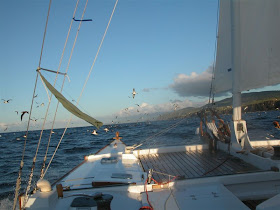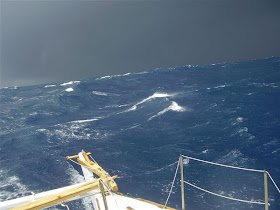I've neglected my posting on this site for way too long, and part of the reason is that I've been so busy writing books. This has been my busiest year ever as an author, with two new non-fiction books released and a contract to write a novel that has to be completed by February. All of these new titles are in the currently exploding survival genre, but these latest ones also offer a lot to anyone interested in boats. Just last week,
Bug Out Vehicles and Shelters: Build and Outfit Your Life-Saving Escape was released, and despite the cover image, it contains three chapters on waterborne transportation, as I am of the persuasion that in most situations boats are better options for evacuating danger zones than land vehicles.
Chapter Three:
Bug Out Boats covers the kind of vessels I consider "escape watercraft". That is, both power and sailing craft that can quickly get you out of a danger zone while carrying everything you need to survive, yet are not large enough to offer self-contained, long-term accommodations. These boats include beach cruisers you camp out of, rather than in, and fast runabouts that quickly get you to a safer location in situations where you may not have time to stop overnight at all.
Chapter Six:
Liveaboard Boats is in the section of the book dedicated to mobile retreats. This kind of boat provides a platform for long-term survival as well as transportation. Vessels suited for both protected brownwater cruising and offshore bluewater voyaging are included here, with an emphasis on simplicity, seaworthiness and reasonable cost. Outfitting and setting up such a boat as a mobile bug-out retreat is not much different than preparing for any type of long-term cruising in possibly remote locations, but special considerations for this use are pointed out.
Chapter Nine:
Human-Powered Watercraft covers canoes, sea kayaks and rowing vessels, as this type of boat can navigate waterways beyond the reach of larger vessels and access remote wilderness areas where safe retreat locations can be found, as well as natural resources for survival. In the event of some kind of sustained shut down of the power and conventional transportation grid, such craft may be the most viable means of travel - especially if stealth and a low profile is needed.
I won't go into many details about the novel project at this point, but I will say that a Wharram catamaran features prominently in the story line. This should probably be expected by long-time readers here, who by now know about my enduring fascination with these Polynesian-style catamarans. A Reuel Parker schooner is also in the story, and a good bit of sailing and passage-making is part of the plot.
The other non-fiction book:
Getting Out Alive: 13 Deadly Scenarios and How Others Survived was published back in March this year, and so is not news, but since it was not mentioned here before, I thought I should do so now as it also has some chapters to offer boating enthusiasts. There's a scenario on surviving a hurricane aboard a sailboat, a scenario in which ill-prepared power boaters get swept out to sea in the Gulf Stream, and a modern-day marooning on a deserted Pacific atoll. All these situations include real-life accounts of people who have actually survived (or perished) in similar scenarios.








